Scorecards
Understand how all of your teams are performing on the metrics you care about at a glance
In order to leverage this feature, you will need to have your teams set up and your other organizational assets assigned to those teams.
Your Organization at a Glance
The Faros scorecard provides a single point where you can understand how your entire organization is performing on the metrics you care about. Like the rest of Faros, the scorecard is completely customizable. This means you can choose which metrics to include and what success looks like for your teams. Scorecards can be found for all Faros Admins and Faros Owners under the Organization menu item.
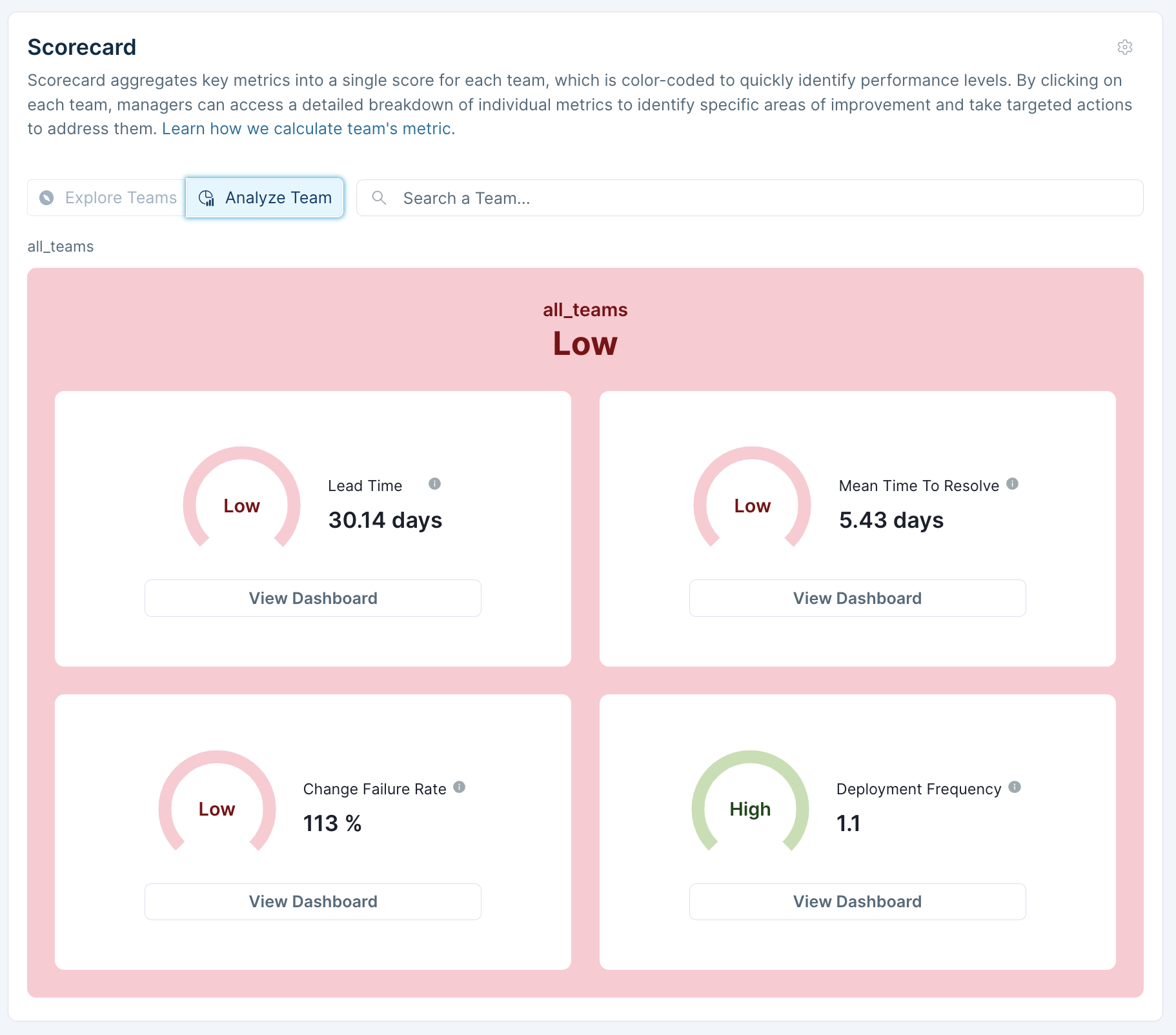
Different Views
Explore Teams
The Explore Teams view lets you see across your entire organization. The rating of a team (color) is computed by aggregating across your key metrics. More information on that below. You can click on a team to drill down or drill up throughout your organization. At any point you can get more detailed information about a given team by choosing to View metrics breakdown or View team page.
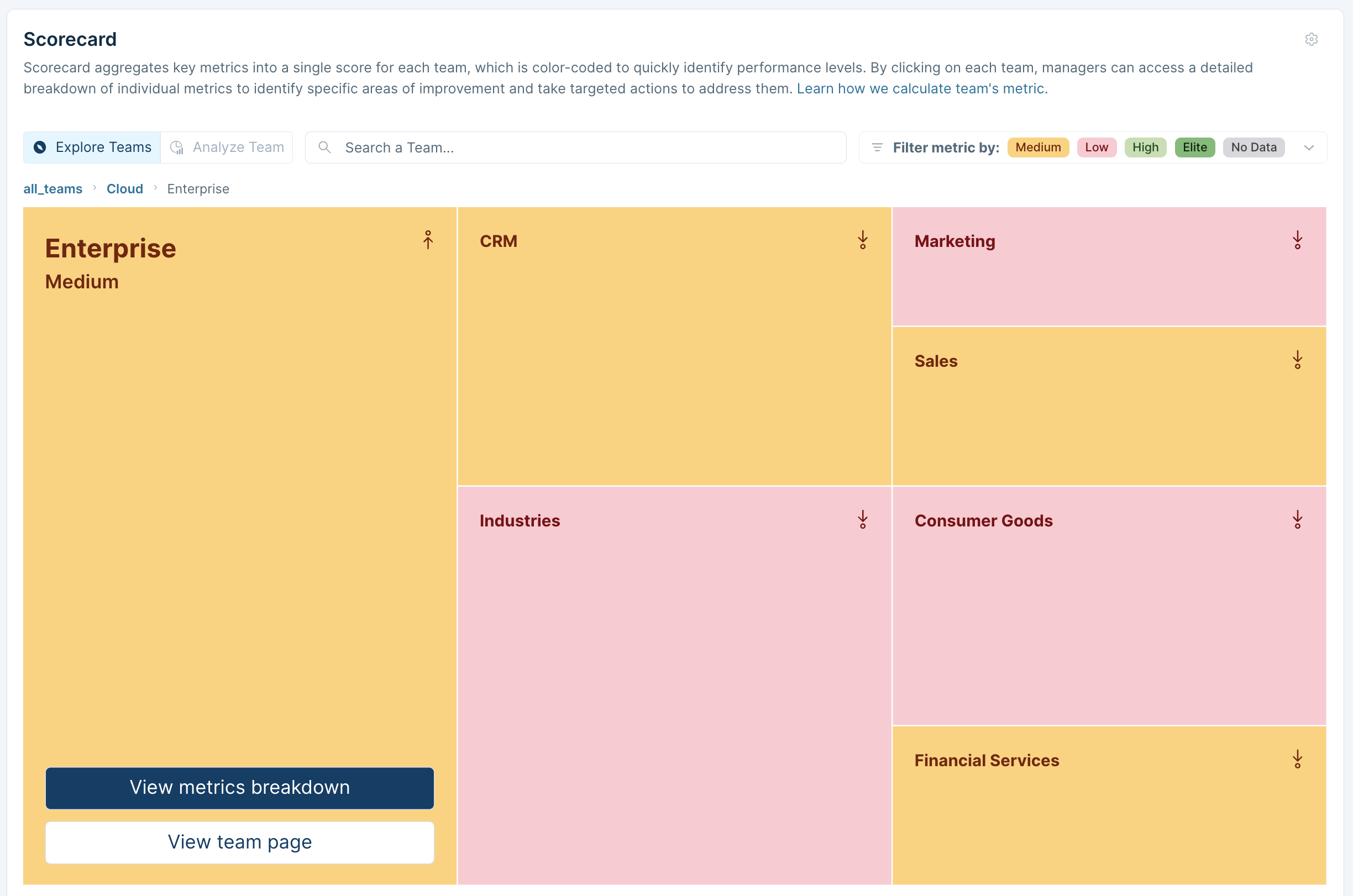
Filtering
At any time you can choose to filter the Explore Team layout. This makes it easier to focus in on the ratings you care about.
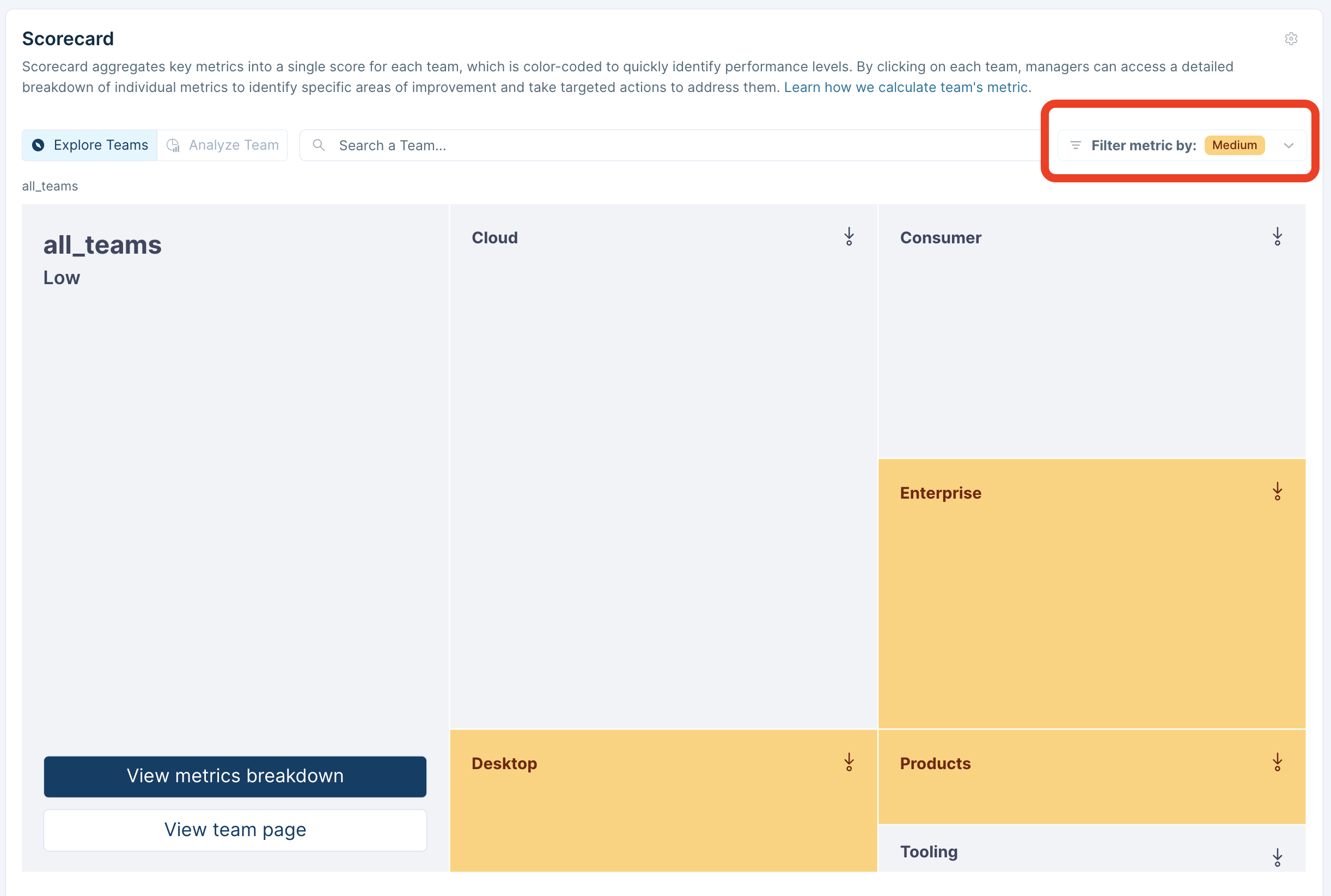
Analyze Team
The Analyze Team view gives you more detailed information on how a team is performing for each of the key metrics.
- You can also see a description for each of the metrics by hovering on the
iicon next to the metric name. - Some metrics are related to a specific dashboard. These metrics will include a
View Dashboardbutton where you can dive deeper into the data behind the metric value. - If a metric does not have an exact value this means the rating (color) was determined by aggregating that metric across its child teams.
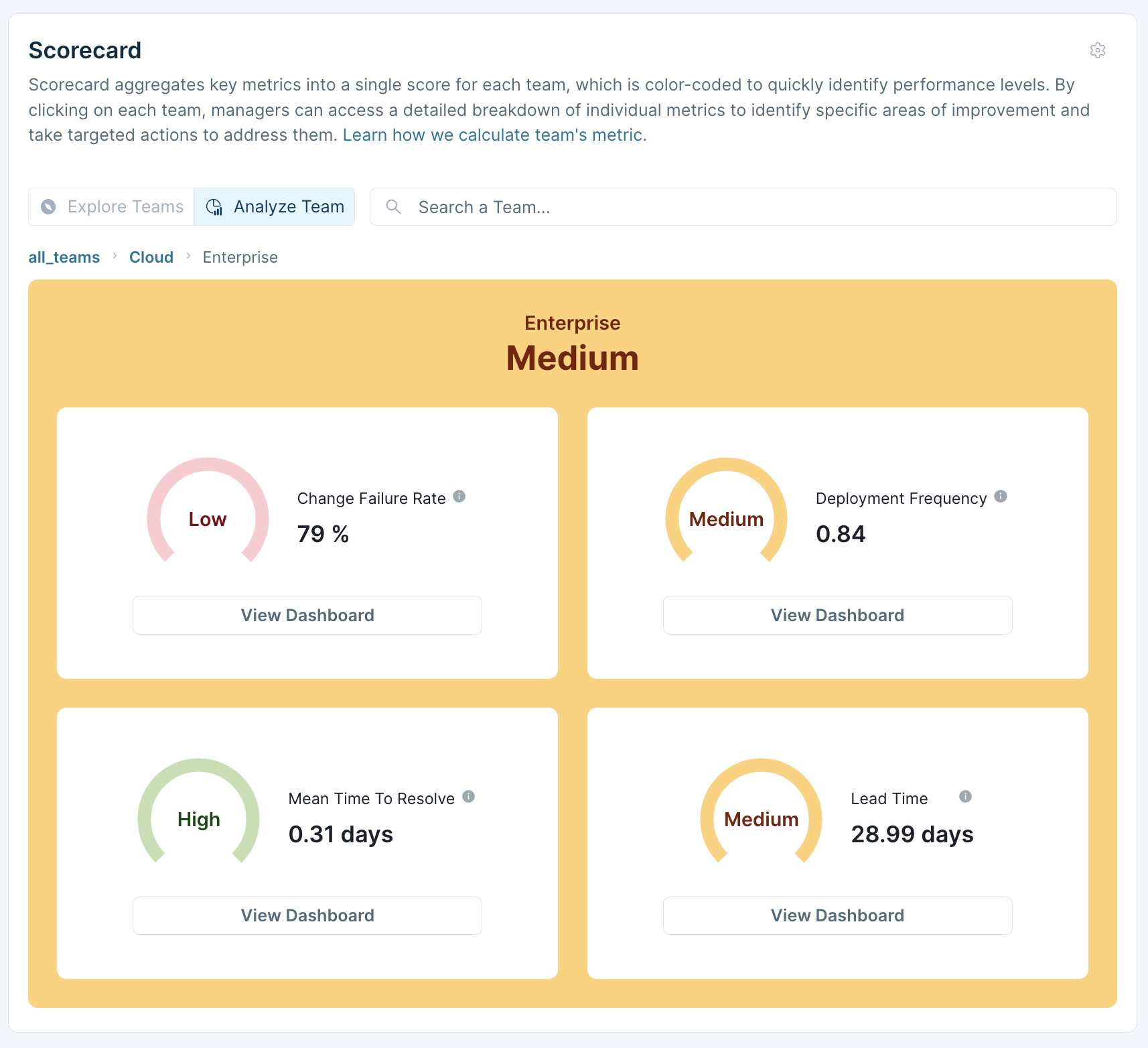
Setup: Selecting your Key Metrics
By default, the scorecard is setup to use the DORA metrics as the enabled key scorecard metrics. To change which metrics the scorecard uses, simply select the settings button in the top right corner of the scorecard and toggle the given metrics on or off based on your preferences. Remember, since the scorecard is for all teams, these metrics will be looked at for all teams.
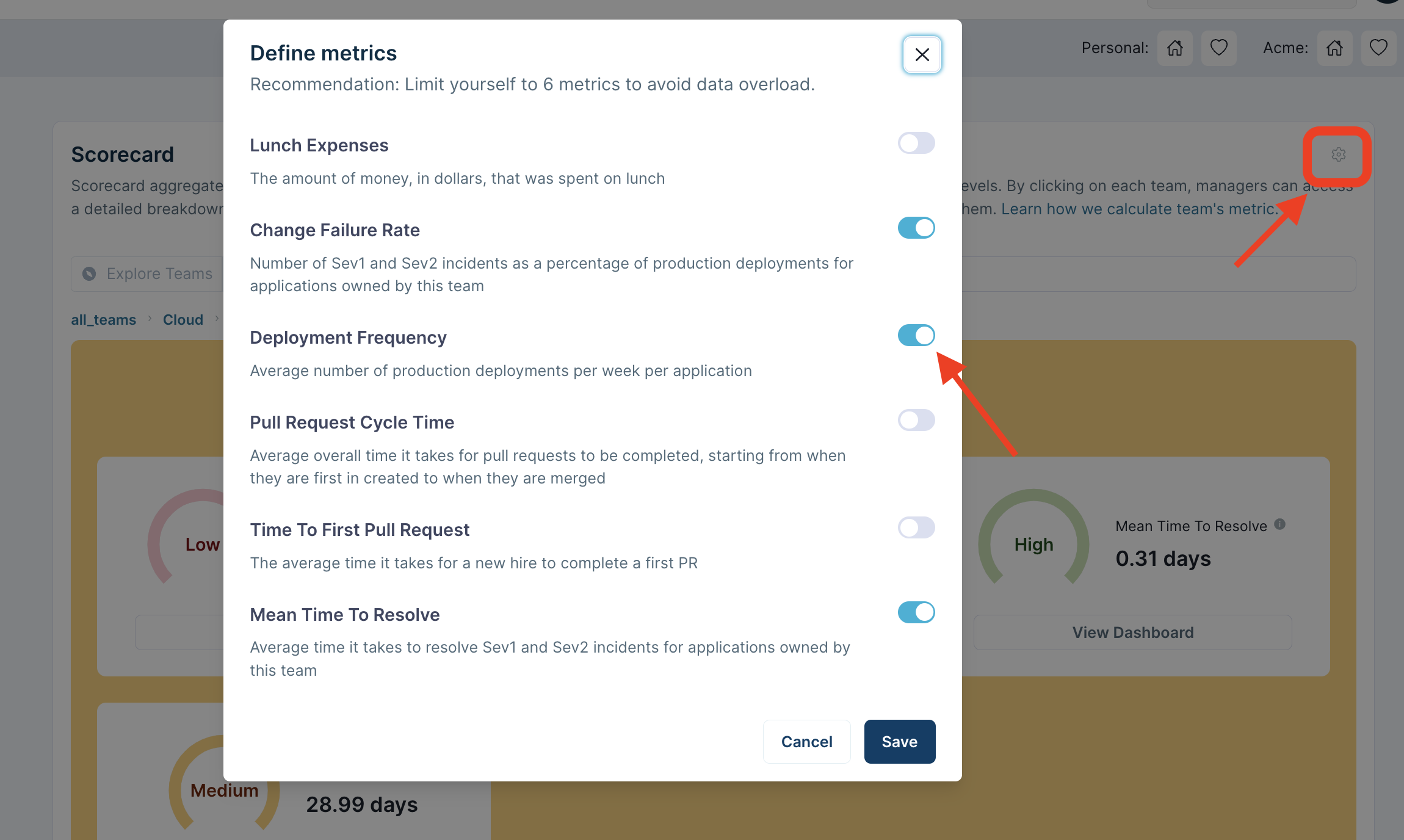
Supported Metrics
Out-of-the-Box metrics
Like Faros Reports, Faros provides certain scorecard metrics available out of the box for customers. These are based on modules and are ready to be turned on in your Scorecard Settings.
Custom Metrics - Beta
It's possible to use custom metrics in the scorecard. This feature is still in development but if you're interested please reach out to [email protected] and we can work with you on a beta version of this feature.
Advanced: How it works
Ratings and Thresholds
Each metric has associated thresholds which are used to determine which bucket, or rating, a metric fits into. Think of thresholds as the definitions for which metric values go into which rating bucket. Each out-of-the-box metric comes with standard thresholds. For any custom metrics users need to define their own thresholds.
Supported Ratings
Faros currently supports the following ratings: Elite, High, Medium and Low
Aggregations
There are two main types of aggregations performed by the scorecard: Overall Team and Inferred Metric.
Overall Team Rating (Color)
For each team we always compute an overall team rating by aggregating all of the key metrics that are enabled for the scorecard. The scorecard uses a simple aggregation where we look at what rating the team has for each of the enabled metrics, then average those numbers.
For example, say a scorecard has three key enabled metrics and teamA has the following ratings for each: Metric1 = Elite, Metric2 = High, Metric3 = Medium. Then Team A's overall rating will be High
Missing Data
If a team doesn't have data for a given metric, that metric is excluded from the aggregation. If all metrics have no data then there is no overall rating for the team and it is considered as having no data as well.
Inferred Metric Rating (Color)
It's possible that we will not always have an exact value for each metric across all of the teams in the organization. This is especially true for metrics that only make sense on the scrum team level. If a team does not have an exact value for one of the key metrics then the scorecard will attempt to infer this metric rating by aggregating across the child teams.
Similar to the way the other aggregations work, the scorecard will look across all of a team's child teams to determine how each perform for the metric in question. It will then aggregate across these ratings to determine what the rating should be for the parent team for that metric.
For example, say we are computing the value for Metric1 for ParentTeam. We will look at all four children of ParentTeam and what their ratings are for Metric1. Say we have the following: ChildTeam1: Metric1=Medium, ChildTeam2: Metric1=Low, ChildTeam3: Metric1=Low, ChildTeam4: Metric1=NoData. Then ParentTeam's rating for Metric1 will be Low.
Missing Data
If a child team has no data for the metric that child team will not be included in the aggregation. If all the child teams have no data for the metric then the parent will also have no data.
How to Tell if a Metric was Computed Using Aggregation
You can tell if a team's metric rating was computed through this aggregation by checking if it has a rating but no value. If the value is missing but it still has a color then this rating was computed by looking at how all of the children teams performed on this metric.

Syncs and timing
Scorecard Metric values come from the same mechanism that populates the data in Faros Dashboards. This means data is updated the same way the dashboards are refreshed.
Scorecard Metrics may not match dashboard metrics exactly. Overall this difference should be negligible. This is because the scorecard metric values are taken from a snapshot of the data at the time the dashboards were refreshed whereas dashboards execute a live query with every view.
Additional Customization
Custom Thresholds
It's possible that you may not want to use the provided thresholds for a given out-of-the-box metric, or you may want different teams to use different definitions of the ratings. For example, an infra team may have a different definition for what is considered an elite number of deployments compared to a front-end app team. Custom thresholds make it possible to add this level of granularity into your metric definitions for both custom and out-of-the-box metrics. Please reach out to us at [email protected] if you are interested in setting up custom thresholds.
Updated 5 months ago
